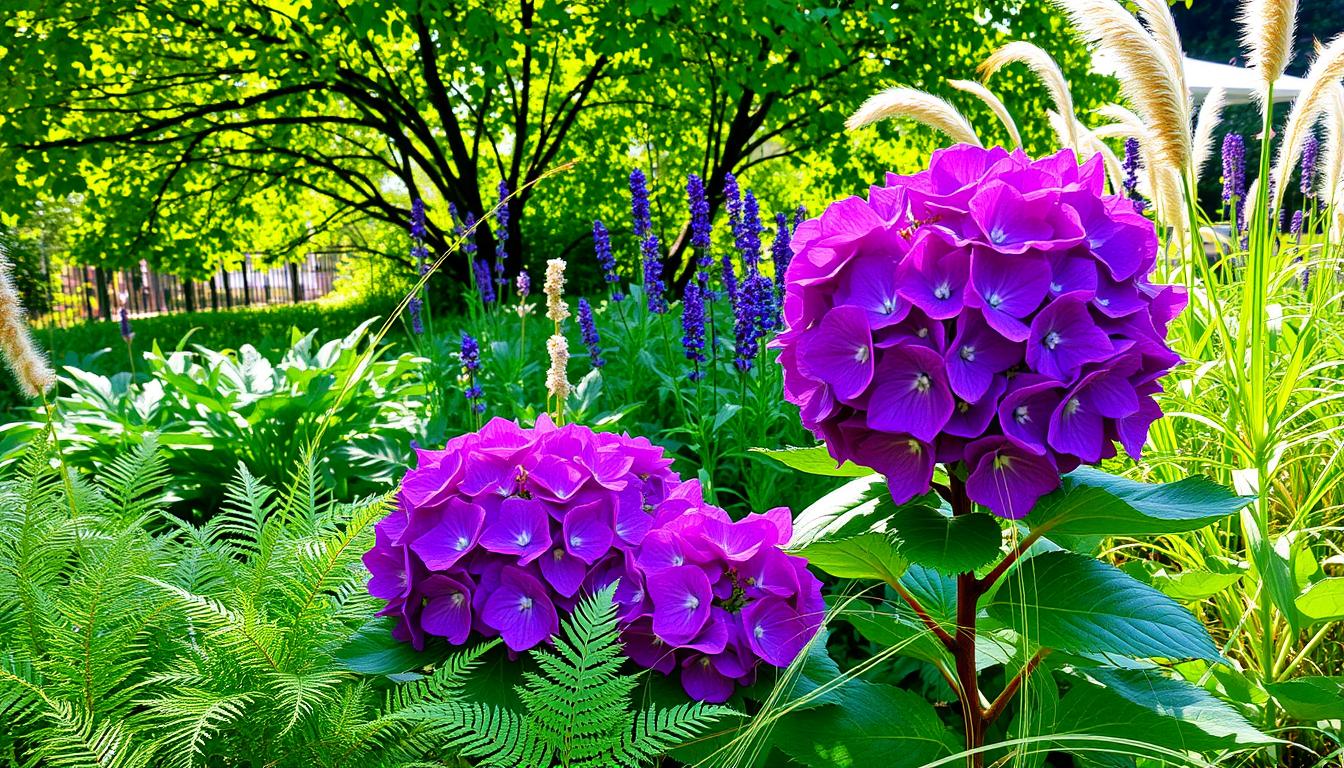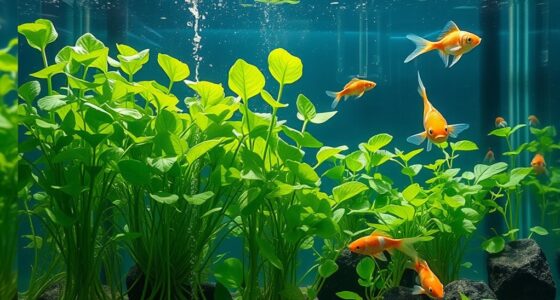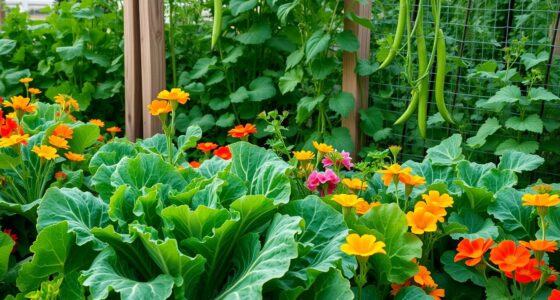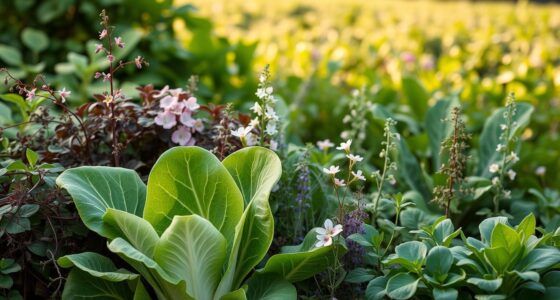Picture yourself in your garden, surrounded by vibrant blooms that dance with the wind, each petal whispering tales of beauty and serenity. Hydrangeas, with their captivating colors and lush foliage, are often the stars of this floral symphony. However, they are not alone in this botanical ballet. The right hydrangea companion plants can elevate your garden’s elegance and vitality, creating an enchanting landscape that invites joy and tranquility. By understanding how to pair these stunning blooms with the best companion plants for hydrangeas, you can nurture a thriving ecosystem that flourishes through every season. Join us as we explore hydrangea landscaping tips that will enhance your outdoor oasis and make it truly your own.
Key Takeaways
- Hydrangeas thrive in diverse environments but benefit from the right companion plants.
- Choosing the best companion plants for hydrangeas can enhance blooming and garden aesthetics.
- Perfect pairings promote a healthy ecosystem and foster the growth of all plants involved.
- Understanding hydrangea needs is key to selecting suitable companion plants.
- A harmonious garden layout can be achieved by thoughtfully pairing hydrangeas with companions.
Understanding Hydrangeas and Their Needs
To cultivate vibrant hydrangeas, understanding their specific requirements is essential. These beautiful plants thrive in conditions that cater to their hydrangea needs, encompassing soil quality, light exposure, and moisture levels. Begin by preparing an optimal environment that supports healthy growth.
Soil Requirements for Healthy Growth
Hydrangeas flourish in rich, well-draining soil for hydrangeas. This kind of soil ensures that water flows freely and prevents root rot. A slightly acidic to neutral pH around 6.0 to 7.0 is ideal. Enhance your soil with organic matter such as compost or aged manure, promoting nutrients essential for robust blooms.
Light Preferences for Hydrangeas
Understanding hydrangea light preferences is crucial for their development. Most hydrangea varieties prefer partial shade, which protects them from the harsh afternoon sun. Some may adapt to full sun conditions, yet too much direct sunlight could lead to scorched leaves. Choose a planting location that balances light and shade for the best outcomes.
Watering Needs for Optimal Blooms
Hydrangeas require consistent moisture to display their exceptional blooms. Regular watering is vital, especially during dry spells. Aim to keep the soil evenly moist but not soggy. Mulching around the base helps retain moisture and maintains a stable temperature in the soil.
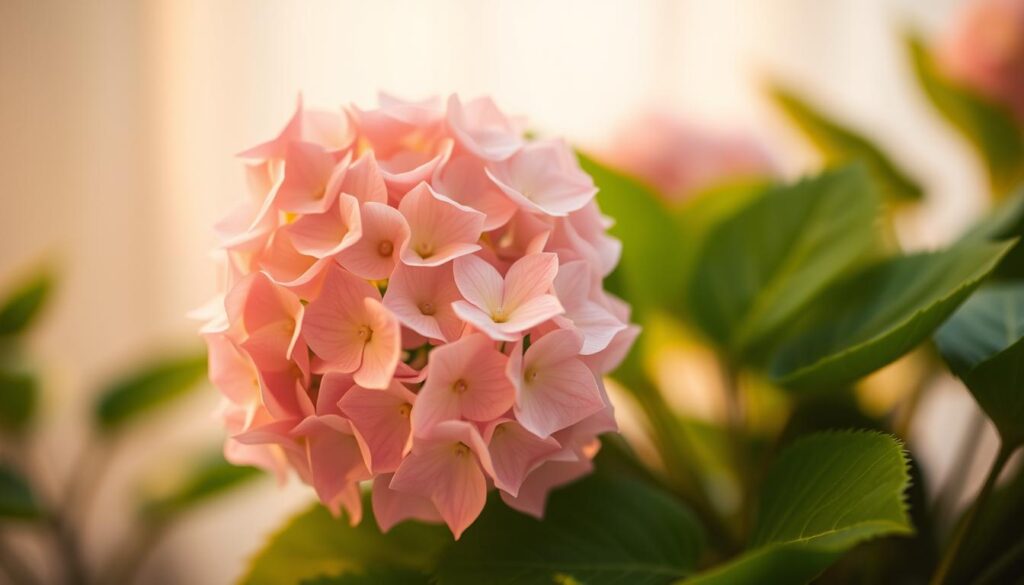
Popular Hydrangea Varieties to Pair
Exploring the diverse world of hydrangea varieties can greatly enhance your garden’s aesthetic. Understanding the characteristics of bigleaf hydrangeas, panicle hydrangeas, and smooth hydrangeas provides insight into finding the perfect companions for these plants.
Bigleaf Hydrangeas
Bigleaf hydrangeas are celebrated for their stunning, large mophead flowers that can transform any garden into a colorful paradise. These plants thrive in USDA zones 5-9. They favor moist, rich soil enriched with organic matter. Regular watering keeps them flourishing, especially in hot weather. The vibrant blooms can range from blues to pinks, depending on soil acidity.
Panicle Hydrangeas
Panicle hydrangeas stand out due to their later blooming season and ability to blossom even in full sun. They are more tolerant of heat than other varieties, making them ideal for sunny spots in your garden. These hydrangeas usually feature cone-shaped flower clusters that begin as creamy white and transition to pink as they mature. They adapt to a variety of soil types, provided they are well-drained.
Smooth Hydrangeas
Smooth hydrangeas possess a robust nature, allowing them to flourish in colder climates. They require less maintenance and can tolerate poor soil conditions better than other hydrangea types. Their creamy white flowers create an elegant look and maintain their beauty throughout the growing season, blooming from summer into fall. These hydrangeas prefer a balance of shade and sun, ensuring healthy growth.
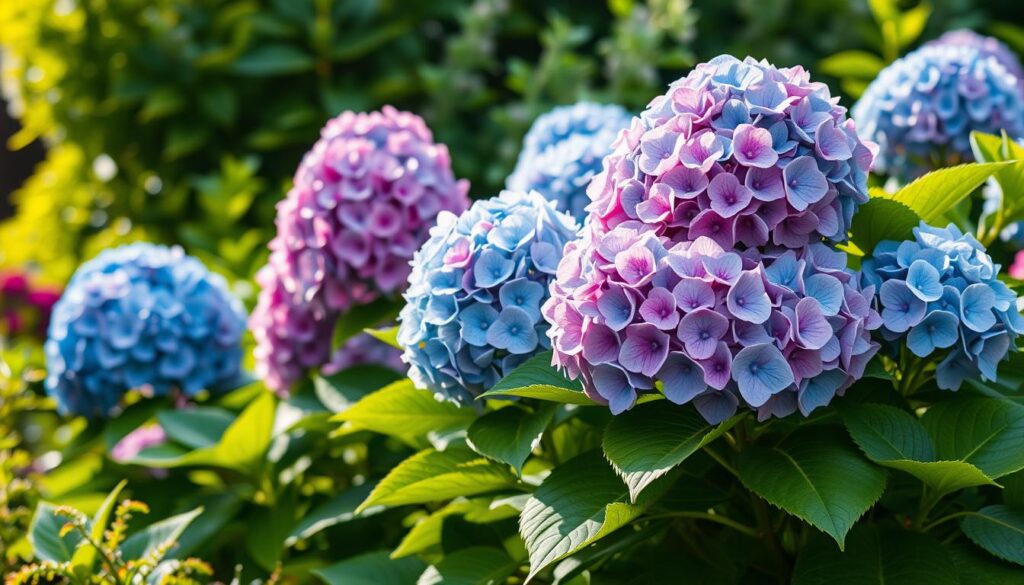
Best Companion Plants for Hydrangeas
When considering the best companion plants for hydrangeas, it’s essential to choose options that not only thrive in similar conditions but also enhance your garden’s overall aesthetic. Perennial plants to pair with hydrangeas provide a solid base, while colorful plants to complement hydrangeas can create striking visual contrasts. Here’s a closer look at some excellent choices for your planting scheme.
Perennials That Thrive with Hydrangeas
Integrating perennial plants to pair with hydrangeas can offer lasting beauty year after year. Consider the following plants:
- Astilbe: Known for its feathery flower spikes, astilbe loves the same moist soil as hydrangeas and adds a soft texture.
- Coral Bells: With their vibrant foliage, these plants provide colorful highlights throughout the growing season.
- Ferns: Offering lush greenery, ferns thrive in the shade and add a natural, forest-like feel to your garden.
Annuals Adding Color to Hydrangea Beds
Annuals can introduce bursts of color that rejuvenate your hydrangea beds. Here are some options:
- Begonias: Their vibrant blooms create a stunning contrast against the hydrangea’s blooms.
- Daylilies: With their range of colors, daylilies can beautifully complement the palette of hydrangeas.
- Pansies: These cheerful flowers come in a variety of colors, perfect for adding a playful touch to your garden.
Foliage Plants Complementing Hydrangeas
Incorporating foliage plants enhances structure and visual interest. Consider these companions:
- Boxwoods: They provide a classic look and deep green contrast to flowering plants.
- Lady’s Mantle: Their unique leaf shapes add texture, and they flourish in similar conditions to hydrangeas.
- Hostas: Excellent for filling in shaded areas, hostas come in various leaf sizes and colors, enriching the green tones in your garden.
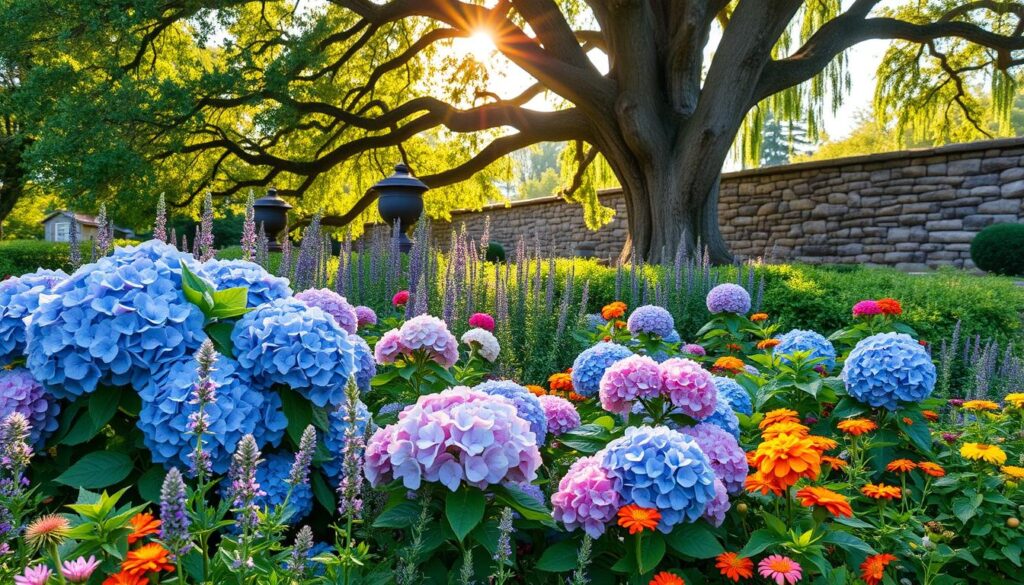
Choosing the right companion plants can significantly enhance the beauty and health of your hydrangea garden. By selecting a mix of perennials, annuals, and foliage plants, you can create a vibrant and cohesive garden space that delights throughout the seasons.
Enhancing Your Garden Layout with Companions
Creating a stunning garden layout with hydrangeas can transform your outdoor space into a picturesque haven. Utilizing effective planting strategies not only highlights the beauty of hydrangeas but also enhances the overall aesthetic and functionality of your garden. By incorporating companion plants, you achieve balance and visual interest while supporting local wildlife.
Layering Plants for Visual Appeal
One of the key hydrangea garden design ideas involves layering plants to create depth. Position taller plants in the back and gradually introduce shorter ones toward the front. This arrangement allows each plant to be visible while adding dimensionality to your garden layout with hydrangeas. Consider using a mix of perennials and annuals that bloom at different times to ensure constant color and interest throughout the seasons.
Creating a Natural Habitat for Pollinators
Integrating plants that attract pollinators will not only beautify your garden but also foster a thriving ecosystem. Companion plants like echinacea, lavender, and bee balm can attract bees, butterflies, and other beneficial insects. By creating a natural habitat through thoughtful placement of these flora alongside your hydrangeas, you will promote overall garden health and biodiversity.
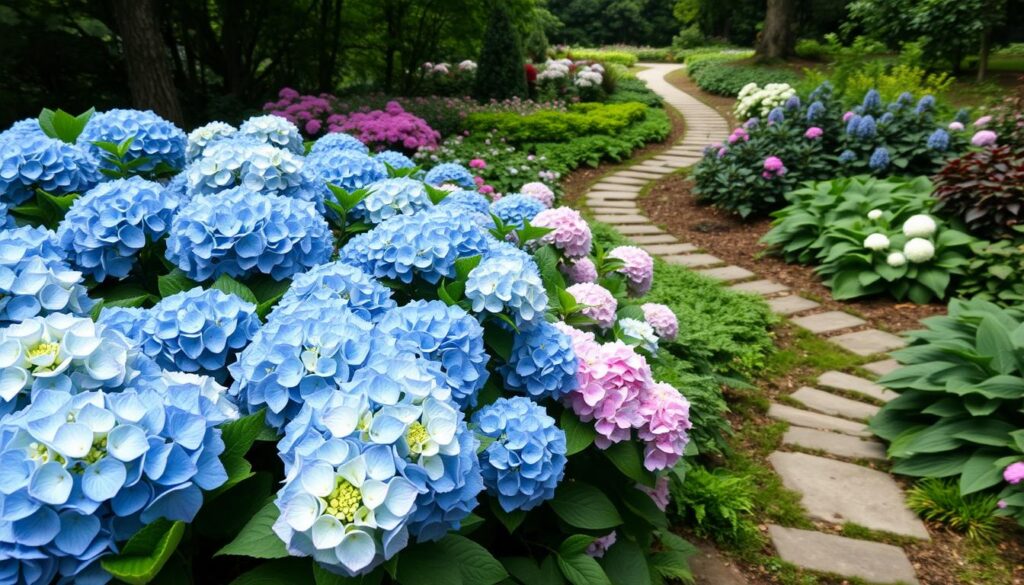
Balancing Colors in Your Hydrangea Garden
Color harmony plays a crucial role in creating a visually striking hydrangea garden. You can employ various *hydrangea landscaping tips* to effectively balance colors, ensuring that your blooms complement each other beautifully. Selecting seasonal combinations and considering the timing of flowering plants can result in a garden that flourishes throughout the year.
Color Combinations That Work
Certain color combinations can enhance the vividness of your hydrangeas. Choose from a palette of complementary hues to create a stunning display. For instance:
- Pink Hydrangeas paired with purple Salvia creates a soft, romantic feel.
- Blue Hydrangeas alongside yellow coreopsis offers a vibrant contrast that captures attention.
- White Hydrangeas mixed with red astilbe provides a classic look with bold accents.
By thoughtfully integrating these combinations, you can achieve a balanced aesthetic that enhances the overall appeal of your hydrangea garden.
Seasonal Color Transformations
Transitioning your garden through the seasons requires an understanding of plant bloom periods. When selecting companion plants, keep in mind those that bloom at different times:
| Season | Hydrangeas | Companion Plants |
|---|---|---|
| Spring | Bigleaf Hydrangeas | Primrose, Lungwort |
| Summer | Panicle Hydrangeas | Daylilies, Echinacea |
| Fall | Smooth Hydrangeas | Asters, Sedums |
By incorporating plants that bloom during different seasons, you contribute to the continuous evolution of color and texture in your garden, making *balancing colors in your hydrangea garden* a rewarding endeavor.

Maintaining Harmony in the Garden
Creating a thriving garden with hydrangeas involves understanding the principles of hydrangea companion plants compatibility. As you consider various species to plant alongside your beloved hydrangeas, it becomes essential to select companions that synergize well with them. This ensures that all plants can coexist peacefully without competing for vital resources.
Companion Plant Compatibility
When choosing companion plants for your hydrangeas, look for those that thrive in similar conditions, such as soil type, light exposure, and moisture requirements. Some ideal companions include:
- Hostas: These shade-loving perennials thrive alongside hydrangeas, enhancing the overall aesthetic.
- Astilbes: Their feathery blooms provide a beautiful contrast to hydrangea flowers.
- Heucheras: Known for their vibrant foliage, these plants add texture and color beneath hydrangeas.
Utilizing these compatible varieties not only improves the garden’s visual appeal but also strengthens overall plant health by fostering a balanced environment.
Avoiding Competitive Plant Species
Avoiding plant competition is crucial for the success of your hydrangea garden. Certain species may overshadow or outcompete hydrangeas for nutrients, water, and sunlight. Common plants to steer clear of include:
- Aggressive ground covers like *Mint*: They can quickly take over space and resources.
- Fast-growing shrubs such as *Elderberry*: These can outpace hydrangeas in growth and create overcrowding.
- Other heavy feeders like *Sunflowers*: They may deplete soil nutrients needed by hydrangeas.
By remaining mindful of hydrangea companion plants compatibility and avoiding competitive species, you create a harmonious environment where your hydrangeas and their companions can thrive together.
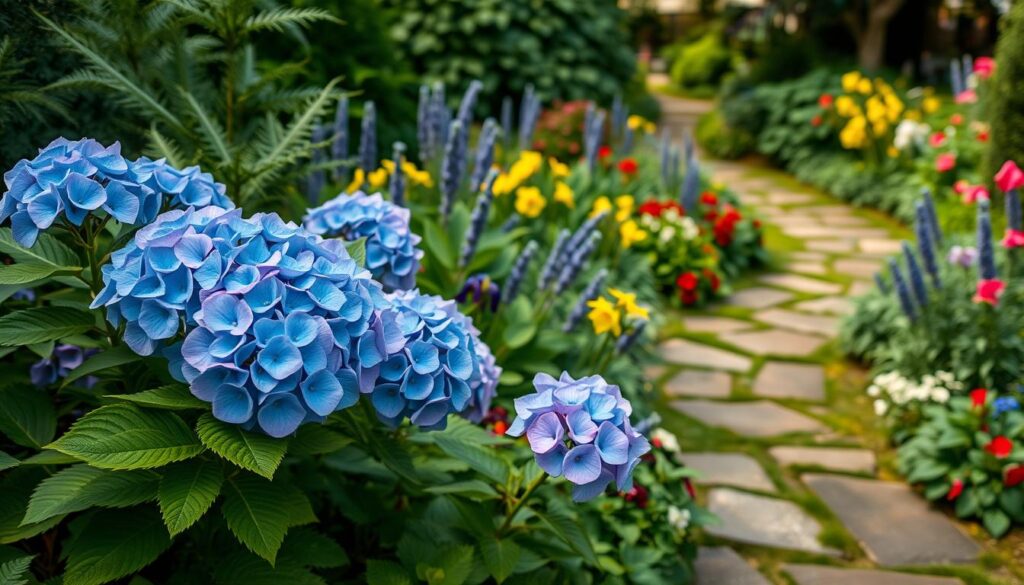
Attracting Pollinators with Companion Plants
Creating a hydrangea pollinator garden is a wonderful way to enhance your landscape while supporting the local ecosystem. By selecting the right companion plants, you can create an inviting environment for beneficial insects, particularly those that aid in cross-pollination.
Flowers That Bring Bees and Butterflies
Consider incorporating flowers that are known for attracting bees and butterflies into your hydrangea pollinator garden. Here are some excellent choices:
- Lavender: This aromatic herb not only compliments hydrangeas aesthetically but also attracts a variety of pollinators.
- Echinacea: Commonly known as coneflower, its vibrant blooms are irresistible to bees and butterflies.
- Salvia: With its abundant flowers, salvia draws in pollinators, making it an excellent companion for hydrangeas.
- Agastache: This perennial is known for its long-lasting blooms and sweet fragrance, attracting a multitude of beneficial insects.
Fostering Biodiversity in Your Garden
Integrating a variety of plants in your hydrangea pollinator garden promotes biodiversity. Native plants, in particular, provide essential resources for local pollinators. Creating diverse habitats within your garden, such as incorporating different heights and bloom times, enhances the ecosystem:
- Plant a mixture of annuals and perennials to ensure continuous blooms throughout the growing season.
- Group plants in clusters rather than single specimens to make them more visible and accessible to pollinators.
- Leave some areas of the garden undisturbed to create natural habitats for overwintering insects.

Seasonal Care for Hydrangea Companions
To maintain a vibrant and thriving garden, proper seasonal care for hydrangeas and their companions is essential. Each season brings specific tasks that contribute to healthy growth and abundant blooms. Good hydrangea care tips help you prepare, maintain, and clean up your garden effectively throughout the year.
Spring Preparations for the Garden
Spring is a crucial time for getting your garden ready. Begin by assessing your hydrangeas and companions to see if any plants need replacing or relocating. It’s an excellent time to fertilize your hydrangeas with a balanced fertilizer, promoting robust growth. Ensure that you check for any winter damage and prune sparingly where necessary.
Summer Maintenance Tips
As the temperatures rise, regular maintenance is vital. Focus on watering deeply and consistently. Avoid overhead watering, which can lead to disease. Deadheading spent blooms encourages further flowering and extends the beauty of your garden. Monitor for pests and treat them promptly to prevent infestations that could affect your hydrangeas.
Fall Cleanup Strategies
Fall is the time to tidy up your garden and prepare for winter. Remove any dead foliage and debris, which can harbor diseases. Thin out crowded areas to ensure proper air circulation among your hydrangeas and companions. Consider applying mulch to protect the roots from winter temperatures and to maintain soil moisture.
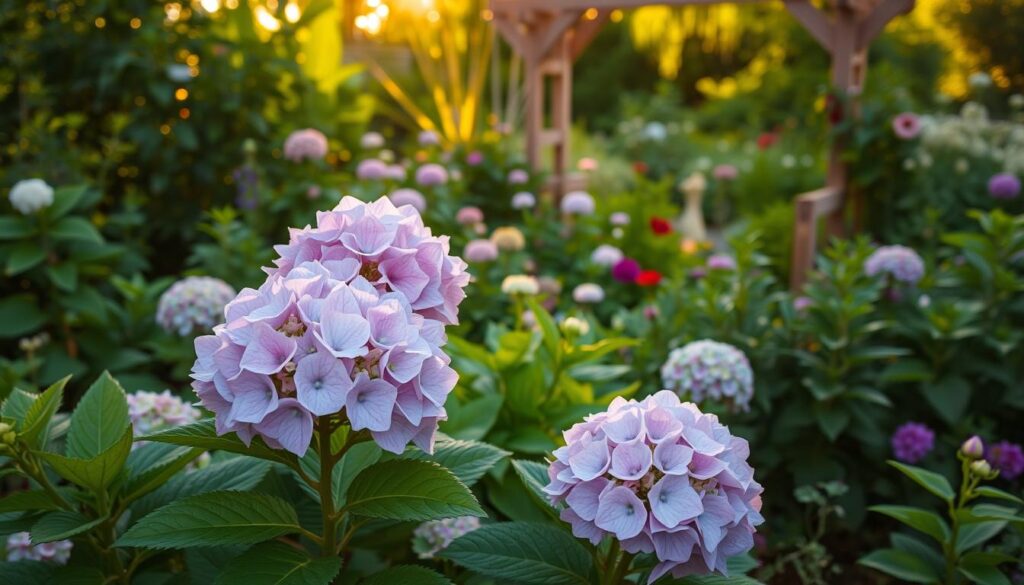
| Season | Key Tasks |
|---|---|
| Spring | Assess and fertilize, prune as needed |
| Summer | Water deeply, deadhead blooms, monitor pests |
| Fall | Clean up debris, thin crowded plants, apply mulch |
Common Pests and Solutions
Maintaining the beauty of your hydrangeas can be challenging, particularly when common pests of hydrangeas invade your garden. Some of the most notorious culprits include aphids, spider mites, and scale insects. Awareness of these pests and their impact on your plants is crucial for cultivation success.
Identifying Pests That Affect Hydrangeas
Familiarizing yourself with the various pests that threaten your hydrangeas can help in early detection and effective management. Look for signs such as wilting leaves, sticky residues, and visible insects. Observing your plants regularly will enhance your ability to identify issues promptly.
Companion Plants That Deter Unwanted Visitors
One of the best strategies to deter pests with companion plants involves integrating specific varieties that repel unwanted insects. Consider planting strong aromatic herbs like lavender or rosemary alongside your hydrangeas. These plants emit scents that many pests find unappealing, thereby reducing their presence. Other effective companions include:
- Marigolds: Known for their vibrant blooms, marigolds can disrupt the life cycle of aphids.
- Nasturtiums: These plants attract pests away from hydrangeas, acting as a trap crop.
- Garlic: Its strong odor repels various insects while promoting biodiversity.
By incorporating these companion plants, you can create a balanced ecosystem in your garden while protecting your beloved hydrangeas.

Fertilizing Strategies for Hydrangeas and Companions
Effective hydrangea fertilizing tips can elevate the overall health and vibrancy of your garden. Understanding the essential nutrients for hydrangeas, such as nitrogen, phosphorus, and potassium, is crucial for promoting growth and blooming. These nutrients play specific roles, helping your plants develop lush foliage and vibrant flowers. Choosing the right type of fertilizer can make a significant difference.
Essential Nutrients for Growth
Hydrangeas require a balanced supply of nutrients to thrive. Nitrogen supports leaf growth, phosphorus stimulates blooming, and potassium aids in root development and overall plant resilience. Pay attention to soil tests that indicate the specific nutrient needs of your plants. This information assists in selecting the right fertilizers, either organic or synthetic, tailored for hydrangeas and their companions.
Timing Your Fertilizer Applications
Proper timing of fertilizer applications enhances nutrient absorption and plant performance. Early spring is an ideal time to start, as hydrangeas begin their growing season. Follow up with additional feedings throughout the summer, particularly during the flowering phase to ensure blooms remain vibrant. Consider using slow-release fertilizers for extended nourishment, allowing your plants to access nutrients steadily over time.
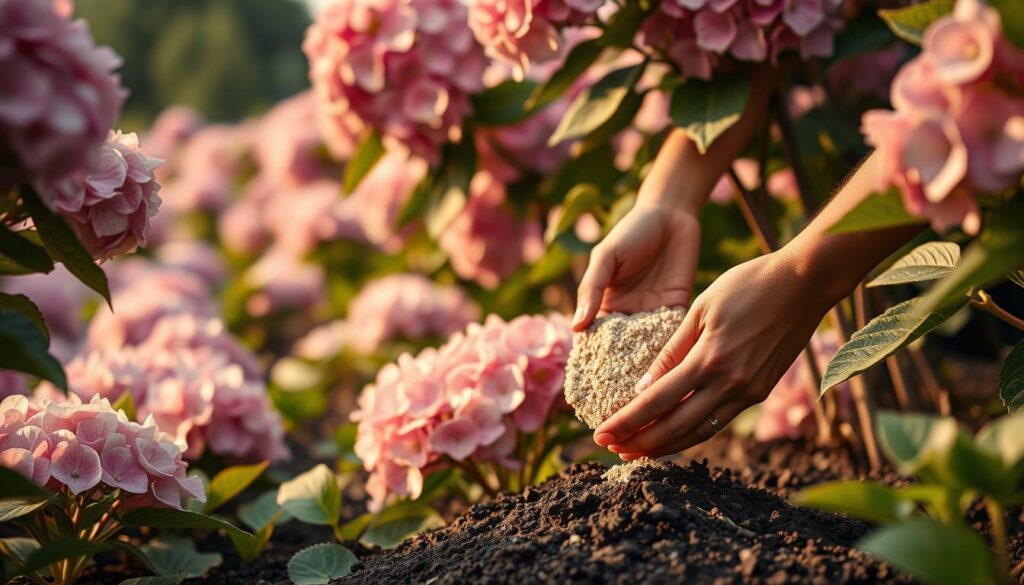
Designing a Hydrangea-Centric Landscape
Incorporating hydrangeas into your garden offers an opportunity to create stunning and colorful displays. You can elevate your hydrangea landscape design by thoughtfully planning paths and borders that showcase these magnificent plants. It’s essential to ensure your design emphasizes the natural beauty of hydrangeas while maintaining a harmonious garden environment.
Paths and Borders to Highlight Hydrangeas
When designing with hydrangeas, consider curved pathways that invite exploration while gracefully framing your blooms. Use materials like gravel or flagstones to create a natural flow that enhances the overall aesthetic. Borders made of low-growing perennials can serve as an eye-catching complement, drawing attention to the hydrangeas and providing a structured appearance. You may choose to incorporate decorative elements, such as garden stakes or pebbles, to accentuate paths and provide visual interest.
Considerations for Plant Spacing
Proper plant spacing is crucial for a thriving hydrangea landscape design. Ensure that you allow for adequate room between hydrangeas and surrounding plants to promote air circulation. This spacing reduces the risk of diseases and allows your hydrangeas to grow to their full potential. Whenever planting, aim for a distance of at least three feet between each hydrangea to provide them with sufficient breathing room and facilitate easy maintenance.

Creating Micro-Climates for Hydrangeas
Creating microclimates for hydrangeas is essential for their health and blooming potential. These tailored environments provide the right conditions that enhance moisture retention and protect the plants from harsh weather. Strategically using companion plants can play a vital role in achieving this ideal setting.
Using Companion Plants for Shade
Utilizing companion plants for shade allows hydrangeas to flourish without the threat of sunburn. Plants like hostas and ferns not only provide the necessary cover but also contribute to the aesthetic appeal of your garden. They create a layered look while offering protection against intense sunlight, ensuring your hydrangeas remain vibrant and healthy.
Windbreaks with Tall Foliage
Tall foliage plants can serve as effective windbreaks, shielding your hydrangeas from harsh winds that can damage delicate blooms and foliage. Varieties such as ornamental grasses or taller shrubs can act as natural barriers, creating a protective environment. This consideration helps maintain stable temperatures around your hydrangeas, further promoting their overall vitality.
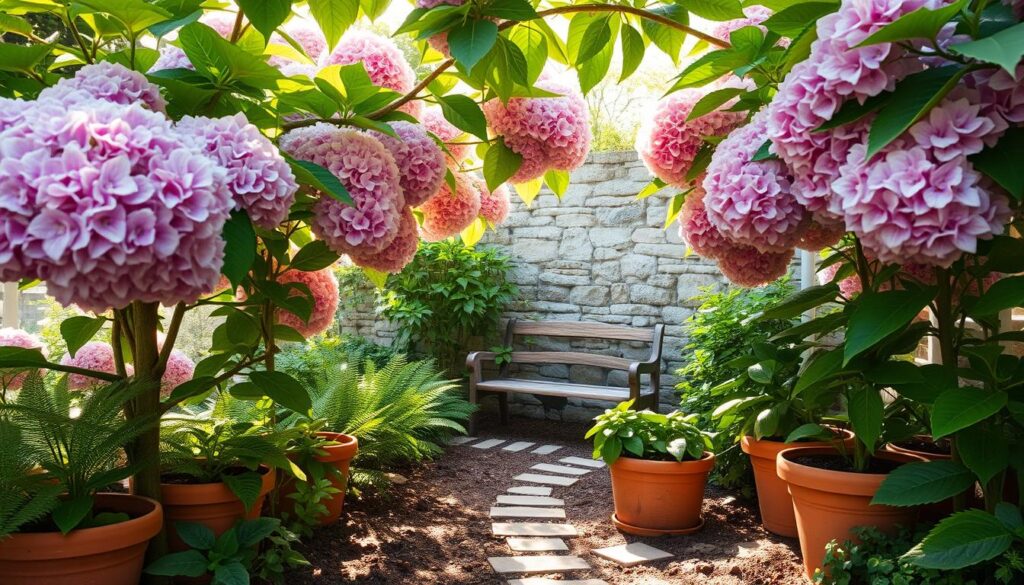
Edible Companion Plants for Your Hydrangea Garden
Integrating edible plants for hydrangeas can enhance the aesthetic and functional diversity of your garden. Companion planting with vegetables creates a harmonious environment, allowing you to enjoy vibrant blooms alongside the fresh flavors of your herbs and veggies. This approach promotes a thriving garden ecosystem while maximizing space.
Herbs That Can Thrive with Hydrangeas
Herbs not only add culinary value but also contribute to the overall health of your hydrangea garden. Consider the following herbs:
- Basil – Thrives in similar conditions as hydrangeas, offering fragrant leaves and a strong aroma that can deter pests.
- Parsley – A versatile herb that grows well in partial shade, making it an ideal companion for your hydrangeas.
- Thyme – This hardy herb adds greenery and can tolerate the moist soil hydrangeas require.
- Chives – Their vibrant purple flowers can create a beautiful contrast with hydrangeas while providing edible benefits.
Vegetables That Pair Well
When considering vegetables for companion planting with vegetables, choose those that thrive in similar growing conditions:
- Green Beans – They can climb, adding vertical interest and utilizing space effectively.
- Radishes – Fast-growing and ideal for interspersing among hydrangeas without crowding them.
- Leafy Greens – Such as spinach and lettuce, these plants enjoy the shaded environment provided by larger hydrangeas.
- Peppers – They share similar water and light requirements, making them successful companions in the garden.
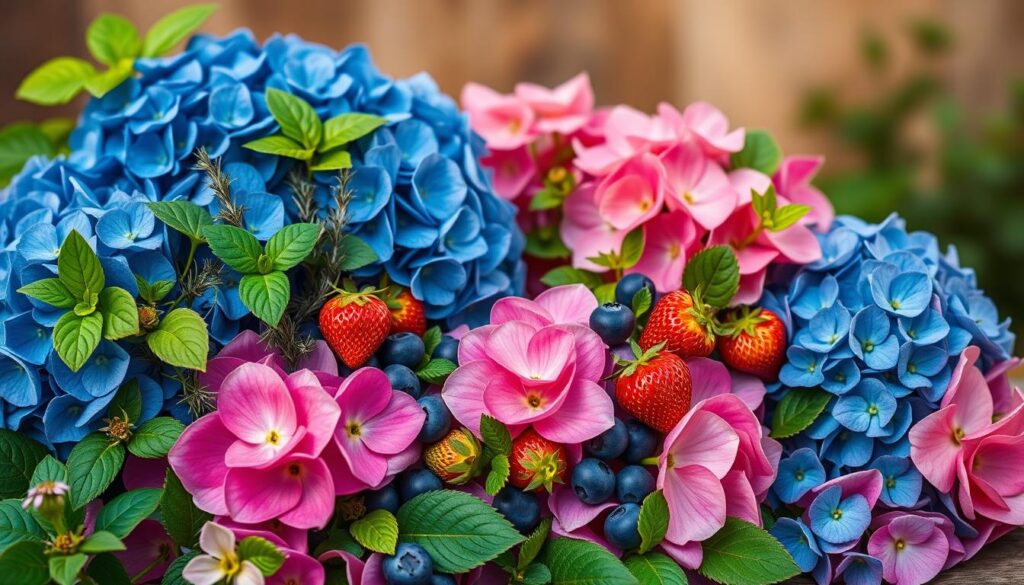
Incorporating Hydrangeas in Mixed Borders
Integrating hydrangeas into mixed borders enhances your garden’s visual appeal while allowing you to showcase various plant species. Employing effective hydrangea garden techniques can create a stunning arrangement, highlighting the unique characteristics of each plant. You can achieve a harmonious balance of colors and textures, making your outdoor space inviting and vibrant.
Techniques for Blending Varieties
When blending different varieties of hydrangeas in mixed borders with hydrangeas, consider a few essential techniques:
- Choose Complementary Colors: Select hydrangea varieties that harmonize with neighboring plants. Pair blue and pink blooms to create a visually stimulating contrast.
- Layering for Depth: Place taller hydrangeas at the back of the border, allowing shorter varieties to flourish in the front. This layering creates depth and visual interest.
- Incorporating Foliage: Combine hydrangeas with plants that have distinct foliage to enhance texture. Variegated or bold leaf plants can complement hydrangeas beautifully.
Balancing Sizes and Heights
Achieving a balance of sizes and heights is crucial when planning mixed borders with hydrangeas. Follow these tips to create a well-proportioned arrangement:
- Plant smaller companions, like hostas or daylilies, in front of shorter hydrangeas.
- For taller varieties, ensure ample space between plants to avoid overcrowding, allowing each to thrive.
- Arrange transitional plants, such as ornamental grasses, between the hydrangeas and other flower types to smooth height variations.
Utilizing these techniques will enhance your garden layout, ensuring that your mixed borders with hydrangeas remain balanced and visually appealing.
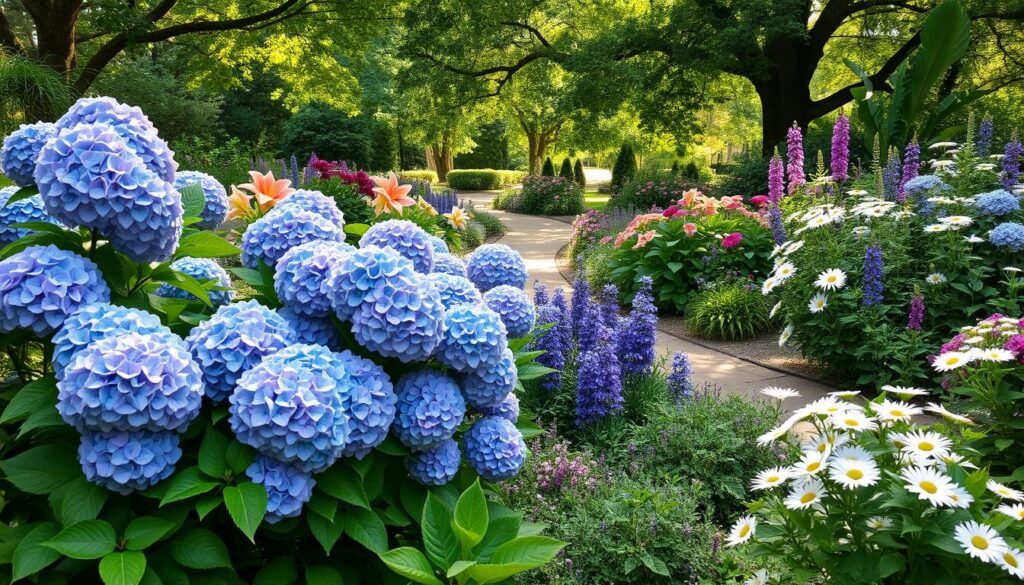
Resources for Further Learning on Hydrangeas
To fully embrace the beauty and care of hydrangeas, it’s essential to arm yourself with the right information. There are numerous hydrangea gardening resources available that delve into various aspects of cultivation, design, and companionship. Exploring dedicated books can provide you with comprehensive insights into choosing the best hydrangea varieties and their optimal growing conditions. Guides such as “The Hydrangea Book” offer expert tips that can greatly enhance your gardening journey.
Books and Guides for Outdoor Enthusiasts
Numerous books cater to outdoor enthusiasts eager to learn about hydrangeas. Titles like “Hydrangeas: The New Subscription” and “The Flower Gardener’s Bible” explore not only the unique characteristics of different varieties but also companion plants that thrive alongside hydrangeas. These resources guide you through the nuances of soil, watering, and sunlight requirements, ensuring your hydrangea garden flourishes beautifully.
Online Communities and Forums
Engaging with online communities and forums can significantly enrich your learning experience. Joining platforms such as Reddit’s gardening subreddit or specialized Facebook groups allows you to connect with fellow hydrangea lovers. In these spaces, you can share experiences, seek advice, and exchange tips, making learning about hydrangeas an interactive experience. The collaborative environment fosters a wealth of knowledge that can lead to successful gardening outcomes in your landscape.
